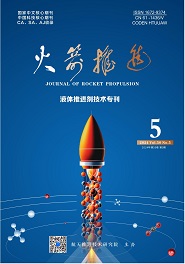航天推进技术研究院主办
LING Sirui,ZHANG Wei.Multi-channel high precision platinum resistance temperature measuring circuit for cryogenic test[J].Journal of Rocket Propulsion,2020,46(03):96-102.
用于低温试验的多通道高精度铂电阻测温电路
- Title:
- Multi-channel high precision platinum resistance temperature measuring circuit for cryogenic test
- 文章编号:
- 1672-9374(2020)03-0096-07
- Keywords:
- temperature measurement circuit; multi-channel; ratiometric measurement; cryogenic test; platinum resistor
- 分类号:
- TH811
- 文献标志码:
- A
- 摘要:
- 在低温推进剂蒸发量控制等低温试验中,高精度的温度测点数量多,并且要求必要时屏蔽失效的测点,导致调理电路成本较高。为解决上述问题,设计了一种适用于低温试验多通道温度测量的铂电阻测温电路。设计了恒流源电路、放大滤波电路。利用ATMega328P和串口屏开发了通道控制和人机交互界面。用于测温的多个铂电阻与已知参考电阻以同一个恒流源串联供电,通过比例式测量消除了恒流源性能对测量精度的影响。误差分析和测试校准证明其电阻测量精度达到0.05%,可广泛应用于实验室和试验现场的低温测量系统中
- Abstract:
- In cryogenic test like cryogenic propellant boil-off control test, a large number of high-precision temperature measuring points are required. As such, issues of conditioning-circuit deployment and its cost, for the purpose of multi-channel measuring and disabling ineffective points, are most pronounced. For this reason, a multi-channel platinum resistance temperature measuring circuit for cryogenic test was realized here. A current source, an amplifying and filtering circuit and an interacting channel control system based on ATMega328P and serial screen were designed. Multiple platinum resistors for measurement were connected in series with a known reference resistor. All resistors were driven by a current source. The influence of current source performance on accuracy was eliminated by comparative measurement. Error analysis and experiments proved that the resistance measuring accuracy is 0.05%. The system can be widely used in cryogenic measurement systems in laboratory and testing field
参考文献/References:
[1] 曹文庆, 谭海林, 李伟. 低温发动机试验推进剂入口温度控制[J]. 火箭推进, 2009, 35(3): 52-54.
CAO W Q, TAN H L, LI W. Propellant inlet temperature control for cryogenic rocket engine tests[J]. Journal of Rocket Propulsion, 2009, 35(3): 52-54.
[2] 徐鸿鹏, 张志涛, 唐斌运, 等. 发动机试验液氧贮箱放气系统动态特性研究[J]. 火箭推进, 2018, 44(5): 71-76.
XU H P, ZHANG Z T, TANG B Y, et al. Study on dynamic characteristics of gas-exhaust-system for liquid oxygen tank used for liquid rocket engine ground test[J]. Journal of Rocket Propulsion, 2018, 44(5): 71-76.
[3] COLEMAN J N. Cryogenic fluid management technology workshop. volume 2: roundtable discussion of technology requirements[J]. Accounts of Chemical Research, 2013, 46(1):14-22.
[4] DOHERTY M, GABY J, SALRMO L, etc. Cryogenic fluid management technology for Moon and Mars missions[C]//AIAA SPACE 2009 Conference & Exposition. Pasadena, California: AIAA, 2009.
[5] MEYER M L, MOTIL S M, GINTY C A, etc. The cryogenic propellant storage and transfer technology demonstration mission: progress and transition[C]// AIAA/ASME/SAE/ASEE Joint Propulsion Conference. [S.l.]:AIAA,2013.
[6] 张少华, 曹岭, 刘海飞, 等. NASA低温推进剂长期在轨贮存与传输技术验证及启示[J]. 导弹与航天运载技术, 2017(3):49-53.
[7] 李鹏, 孙培杰, 盛敏健, 等. 推进飞行器低温推进剂在轨贮存被动蒸发控制方案研究[J]. 载人航天,2018,24(1):91-97.
[8] 郑建朋, 崔晨, 陈六彪, 等. 低温推进剂贮箱绝热性能实验研究[J]. 真空与低温,2016, 22(1):26-29.
[9] 周振君, 雷刚, 王天祥, 等. 低温液氮贮箱静置增压及放气特性分析[J]. 低温与超导, 2015, 43(12): 10-12.
[10] 雷震, 李怡, 付琳琳. 液氧主容器温度测量误差分析与改进方法[J]. 火箭推进, 2015, 41(6): 92-98.
LEI Z, LI Y, FU L L. Analysis and improvement methods for temperature measurement error of LO2 main container[J]. Journal of Rocket Propulsion, 2015, 41(6): 92-98.
[11] 梁怀喜, 韩战秀, 李清. 密闭容器漏热液氢饱和过程分析[J]. 火箭推进, 2018, 44(3): 49-53.
LIANG H X, HAN Z X, LI Q. Analysis on saturation process of liquid hydrogen with heat leakage in closed container[J]. Journal of Rocket Propulsion, 2018, 44(3): 49-53.
[12] 姜冬玲, 杨莹. 液氧温度对某液氧液氢发动机性能影响研究[J]. 火箭推进, 2014, 40(2): 54-58.
JIANG D L, YANG Y. Influence of LOX temperature on LOX/LH2rocket engine performance[J]. Journal of Rocket Propulsion, 2014, 40(2): 54-58.
[13] 王永. 低温流体输送过程中基于铂电阻温度传感器测温误差建模与分析[D]. 南京: 东南大学, 2017.
[14] 王晶晶, 李芳培, 李安顺. 低温推进剂火箭超低温温度测量技术[J]. 重庆理工大学学报(自然科学), 2012, 26(10): 42-45.
[15] 赵振宇, 白洁, 冯浩. 铂电阻型温度传感器信号调理电路设计[J]. 微电机, 2019, 52(4): 75-78.
[16] 姚爱琴, 马忠亮, 孙运强. 热敏电阻测量法的比较研究[J]. 测试技术学报, 2002, 16(1): 59-61.
[17] 顾吉林, 刘淼, 耿杨, 等. 基于PT100的高精度温度测量电路的设计[J]. 测控技术, 2018, 37(5): 101-103.
[18] 廖晖, 刘述钢, 高永毅. 基于Pt100的配电终端温度测量系统设计[J]. 信息通信, 2018, 31(9): 68-70.
[19] 张晓曦, 窦爱萍, 贾超群. 基于ADS1148的铂电阻测温电路设计[J]. 信息通信, 2017, 30(4): 84-86.
[20] 党向婷, 肖军. 基于恒流源激励的PT100测温电路在锅炉控制系统中的应用与研究[J]. 电子设计工程, 2019, 27(5): 77-80.
[21] JOSEPH W. A basic guide to RTD measurements [EB/OL]. [2019-5-17]. www.ti.com/lit/an/sbaa275/ sbaa275.pdf.
[22] JOHN M H. Arduino技术指南[M]. 北京: 人民邮电出版社, 2017.
[23] 郑晓庆, 杨日杰, 赵轩坤. 智能串口显示终端在温度测试系统中的应用[J]. 微型机与应用, 2013, 32(19): 19-21.
[24] 公茂法, 刘建平, 徐新源, 等. 基于串口屏的井下多回路电网监测仪的设计[J]. 煤矿机械, 2013, 34(1): 262-264.
[25] 全国温度计量技术委员会. 标准铂电阻温度计检定规程: JJG 160—2007[S]. 北京: 中国计量出版社,2007.
备注/Memo
收稿日期:2019-05-27; 修回日期:2019-09-09
基金项目:液体火箭发动机技术重点实验室基金项目(6142704050109)
作者简介:凌思睿(1988—),男,硕士,工程师,研究领域为液体火箭发动机地面试验测控技术
